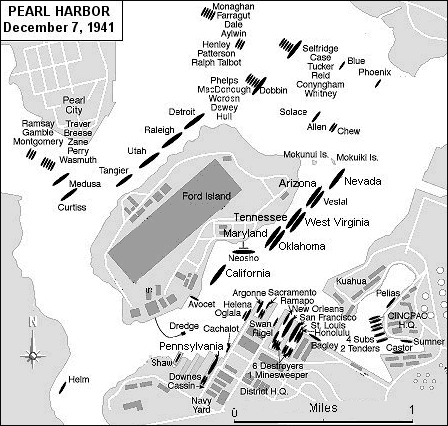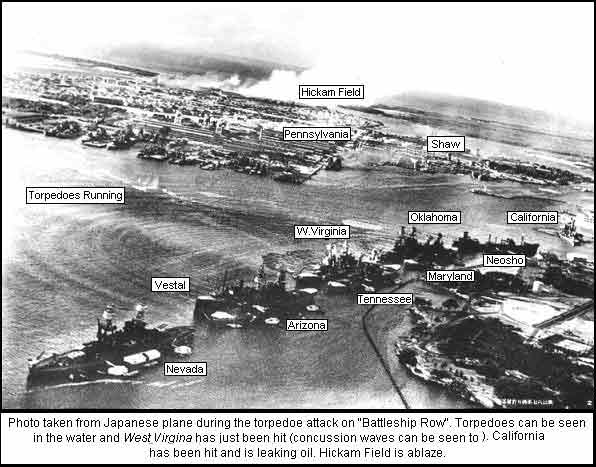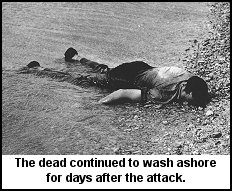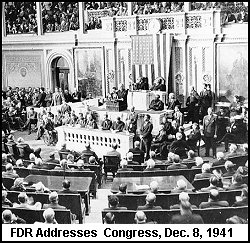| The
Attack - Chronology of Events |
occupied
by Shaw is hit and starts to sink as fires erupt on the ship.
0910
Several
fires start on Nevada and flooding is getting serious. The captain
decides to beach the ship rather than have her sink and block the channel.
Power for the dry dock is cut, leaving the Pennsylvania without
electricity, reducing her ability to fire at the attacking aircraft. The
tender Curtis is struck by a bomb which starts a fire on board.
0920
The main
dry dock housing Pennsylvania and the destroyers Downes and
Cassin
begins to flood. The fire on Downes is out of control and the
order to abandon ship is given.
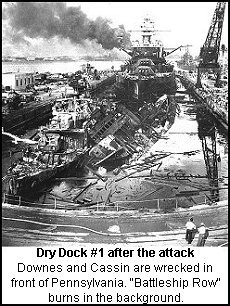
0925
Another
bomb hits the forward section of Downes causing yet another major
fire. This one reaches the torpedo storage room and causes a massive explosion.
0930 (1500 Washington)
Roosevelt
meets with his “war cabinet” and orders the grounding of all private aircraft,
the arrest of all Japanese and German aliens and prepares his speech to
congress requesting a declaration of war. Some debate started on whether
he should ask for a decoration against Germany, but FDR quickly put an
end to this, indicating that he would not do anything to threaten the unity
of the nation, as he felt such a request would give the isolationist Republicans
an opening to cause trouble.
0930
A second
major fire starts on the California on the main deck, starboard
side. Secondary explosions on the destroyers Downes and Cassin
are
reported as fires reach magazines and torpedo stores. The fires on Shaw
burn to the forward magazine and the bow is destroyed in a terrific
explosion.
.
0940
Fires
reaches ammunition stores on the destroyer Downes and the ship explodes,
starting a minor fire at the bow of the Pennsylvania. Some destroyers
anchored on the north side of Ford Island get underway.
0950
Some
destroyers moored at the Naval Yard get underway.
0955
A fire
starts on the bow of Maryland. The hospital ship Solace gets
underway.
1000
The second
wave of Japanese aircraft withdraws. The crew of California is ordered
to abandon ship as advancing oil fires on the water threaten to engulf
the ship. The stern fire on Maryland is out and the bow fire is
under control.
1010
Shortly
after all are off the ship, California is engulfed in flames that
start numerous new fires. The main dry dock is flooded enough that on-board
pumps and lines can start to be used to fight the fires on Pennsylvania
and
destroyers Downes and Cassin.
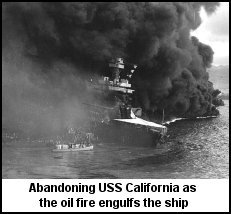
1015
California
was remanned and the abandon ship canceled as the oil fire subsided enough
to allow men on deck.
1200
All
Japanese aircraft are recovered. The flight officers passionately argued
with Admiral Nagumo to launch a third attack against the facilities at
Pearl Harbor. However, Nagumo had completed what he was ordered to do,
did not know of the location of the American carriers and was still in
range of land-based bombers and felt his forces had been fortunate to do
what they had. He ordered the fleet back to Japan.
1400
Reports
arrive at Pearl Harbor that Japanese bombers have hit Wake Island savaging
the planes delivered there just four days ago by Enterprise.
1630
Maryland
reports that all fires are out on board the ship.
1830
(1200 Manila)
Japanese
bombers based in Formosa hit Clark Field in the Philippines. Despite having
over ten hours of warning, Macarthur chose to remain passive and did not
execute the pre-war plan to use his B-17s to strike first. The American
bomber force is destroyed and most of the fighter protection with it. |
|
The following
outlines the events of December 7. All times are Hawaii local unless otherwise
noted.
2130-December
6 (0300-Washington)
An
intercepted “Purple Code” (diplomatic message) message is in the hands
of American intelligence services.
0030
(0600-Washington)
A portion
of the message received earlier in the day is translated the message instructs
the Japanese consulate to inform the U.S. government at 1300 local time
that all negotiations are at an end.
0245
A Japanese
submarine launches 5 midget submarines who’s goal is to enter Pearl Harbor
and destroy any shipping they can.
0345
(0915-Washington)
Admiral
Stark, chief of Naval Operations, is told of the intercept announcing the
end of negotiations and the 1300 notification time. One of his staff points
out that that is about sunrise in Malaysia and the Philippines, both of
which are the suspected targets for Japanese aggression. No mention is
made of Pearl Harbor.
0420
(0950-Washington)
The Secretary
of State Hull is briefed on the intercept.
0445
The destroyer
Ward,
on port patrol at Pearl Harbor, spots a periscope and begins operations
against the suspected enemy target.
0500
(1030-Washington)
After
returning from his regular morning ride, General Marshall, Army Chief of
Staff, is informed of the intercepted message. He immediately discusses
a joint war warning with Admiral Stark. Stark is not concerned about the
message and decides not to react to it.
0545
The destroyer
Ward,
having made no contact, breaks off the search for the enemy submarine.
Two minesweepers, also on harbor patrol, pass the submarine nets guarding
the harbor. Two Japanese midget submarines pass through the gate with them.
0600
(1130-Washington)
General
Marshall issues his war warning to Army units, but the message would not
be received by all units, including those at Pearl Harbor, for several
hours due to communications foul-ups.
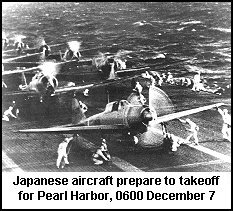
0630
Admiral
Nagumo launches the first wave attack. The force consists of 50 level bombers
(carrying 1760# armor-piercing bombs), 51 dive bombers (with 550# general
purpose bombs), and the entire complement of 70 torpedo bombers. The attack
aircraft are escorted by 43 Zero fighters.
0645
After
spotting another periscope Ward, engages the target, a midget submarine,
and sinks it.
0700
(1230 Washington)
Japanese
ambassador Nomura contacts Secretary of State Hull’s office and asks for
a postponement of their meeting for 45 minutes. The embassy staff was having
difficulties in decoding the message (a message which was already in Hull’s
hands through US intelligence efforts).
0710
Trainees
at the radar station spot a large number of targets 137 miles from Oahu.
The crew did not report the contact as they were practicing after their
normal training time (which ended at 0700) and they thought they were either
mistaken, the B-17s expected in from the mainland or planes from the Enterprise.
0715
Admiral
Kimmel, commander of Pearl Harbor, is informed of the engagement between
the Ward and the suspected Japanese submarine. He and his staff
conclude that it is just another false alarm. Admiral Kimmel decided to
go to his HQ to clarify the situation but admitted that he hoped it would
all blow over as he and General Short had a regular Sunday morning golf
game scheduled.
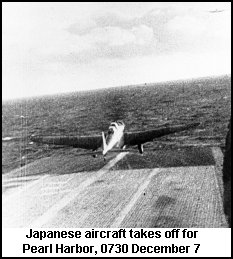
0725
Admiral
Nagumo launches the second wave of planes at Pearl Harbor. This wave consists
of 54 bombers, 80 dive bombers, and 36 fighters.
0730
(0000 – Malaysia)
General
Yamashita’s invasion force arrives off the coast of Malaysia at Kota Baharu
and begins the bombardment of the 9th Indian Division’s positions
in preparation for landings.
0753
Japanese
bombers attack the various airfields around Pearl Harbor, causing a great
deal of damage to the tightly packed aircraft. Wheeler field is hit particularly
hard in the initial attacks but none escape attention. Pearl Harbor’s
air support is wrecked in the first moments of the attack.
0757
General
Quarters is sounded on ships in |
the
harbor as bombs are observed hitting the southwest hangers on Ford Island.
The Tennessee immediately takes two bomb hits, one penetrating in
front of turret III causing a major fire on her stern. The West Virginia
takes 3-4 torpedoes that causes serious flooding and also takes several
bomb hits that start fires on her quarterdeck.Arizona
is hit by several bombs including one that penetrated the deck next to
turret IV. She immediately goes down by the bow, starts leaking massive
quantities of fuel oil and major fires start throughout the ship. Okalahoma
is hit by three torpedoes that tear open her port side hull. She takes
on a 45o list. The cruiser Helena is struck by a torpedo
which causes serious flooding. The cruiser Raleigh is hit by a torpedo,
takes on water quickly, but immediate counter flooding saves the ship from
capsizing.
0800
Nevada
is struck by a torpedo. West Virginia takes another torpedo hit
and immediately takes on a 20-25o list to port. Two more torpedoes
hit Oklahoma, but because of her list, they hit the belt armor.
The additional damage is sufficient to start her rolling more. Anti-aircraft
machine guns open fire on the attacking aircraft. The target ship Utah
(converted battleship) is hit by a torpedo and takes on an immediate 15o
list and continues to roll.
0800
(1330 Washington)
News
of the attack on Pearl Harbor reaches Washington. The universal reaction
was that the report had mistaken Pearl Harbor for the Philippines, but
the messages were quickly confirmed. Secretary Hull was preparing to meet
the Japanese representatives. Although in a state of shock, he met them.
After glancing at the document, Hull angrily said, “In all my fifty years
of public service I have never seen such a document that was more crowded
with infamous falsehood and distortions”. The Japanese diplomats beat a
hasty retreat and as the door closed, Hull muttered, “Scoundrels and piss-ants”.
0805
Two torpedoes
strike the port side of the California. West Virginia takes on a
list of 21o list to port.
0810
Oklahoma
capsizes
and sits hull up with a 135o list. 450 of her crew are trapped.
Heavy 3” and 5” anti-aircraft guns open fire on the attacking aircraft
from the ships still in the fight. The California is hit by several
bombs that cause severe flooding in the lower decks and cuts her power
for guns and damage control. The West Virginia begins counter-flooding
to keep her upright.
0812
A bomb
penetrates the deck armor and detonates in the forward magazine of Arizona.
The ship explodes, tearing the bow of the ship apart and tipping the forecastle
forward. She settles on the bottom with a thousand sailors trapped below
deck.
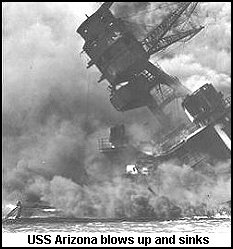
0813
Target
ship Utah capsizes. Most of her skeleton crew escape.
0820
Two more
torpedoes hit the port side of the California.
0825
The last
of the first wave of Japanese planes, having expended their ordnance and
exhausted their machine gun and cannon ammunition in strafing runs, withdraws.
0826
Tender
Curtis
spots a periscope in the harbor and immediately engages it with her 5”
gun, scoring several hits.
0830
The California
is
down by the stern. Nevada gets underway and starts picking her way
through the smoke and fires, moving down the main channel toward the sea.
Destroyer Monaghan gets underway and begins to exit the port.
0840
A Japanese
midget submarine fires its torpedo at Curtis. The destroyer Monaghan
rams the enemy submarine, sinking her.
0845
Admiral
Kimmel arrives at his office and while looking at the destruction of his
fleet, a spent 12.7mm shell comes through the window, tearing his uniform
and grazing his skin. Stooping to pick up the projectile, he said, “It
would have been merciful had it killed me.”
0855
The second
wave of Japanese aircraft arrive and begin their attacks. A few Army P-40s
which were able to get airborne and attack the enemy planes.
0900
With
all guns out of action, her hull resting on the bottom, and fires out of
control, the survivors of Arizona are ordered to abandon ship.
A
bomb hits Raleigh causing another fire to break out.
0905
Level
bombers attack the main dry dock, hitting Pennsylvania and the destroyer
Downes.
Fires rage on both Downes and Cassin. Nevada,
passing through the channel between California and Dry Dock 1 is
engaged by several dive bombers and strafing aircraft. It is hit by at
least one more torpedo and six bombs. An armor-piercing bomb penetrates
the deck of the California starting a major fire. The
floating drydock
|

